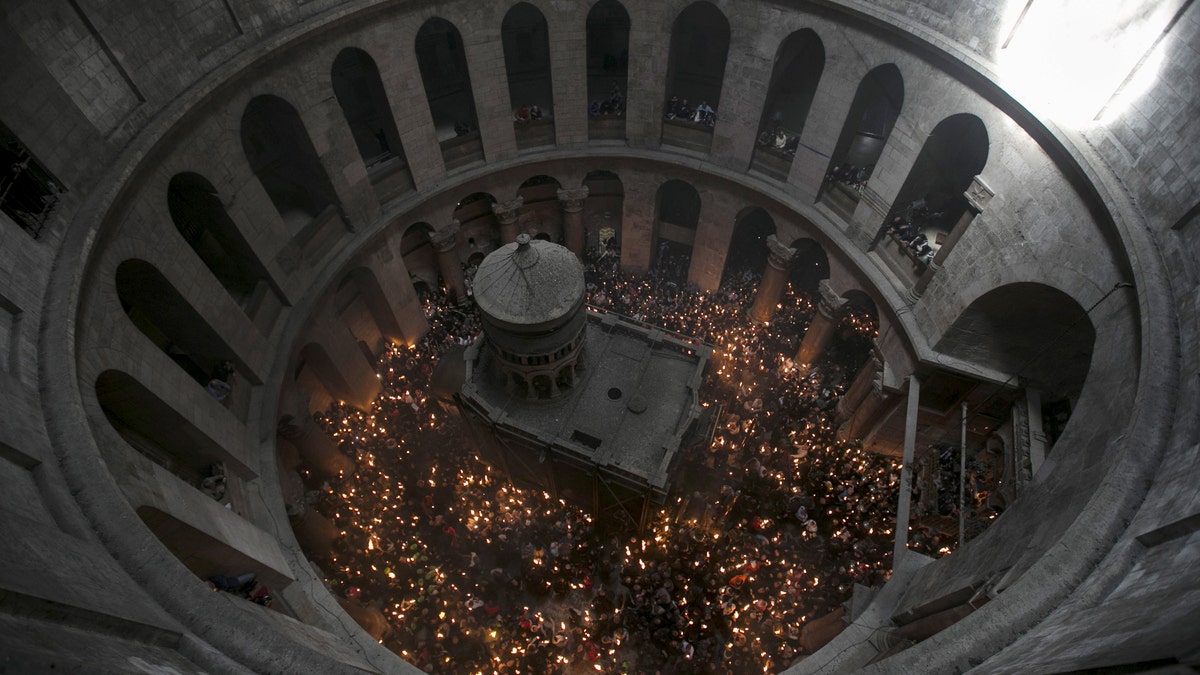
This Wednesday Oct. 26, 2016 shows the moment workers remove the top marble layer of the tomb in Jerusalem's Church of Holy Sepulchre. (Dusan Vranic/National Geographic via AP)
After uncovering the stone slab venerated as Jesus Christ's burial place, archaeologists have now examined the interior of the tomb in Jerusalem’s Church of the Holy Sepulchre.
The tomb is a limestone shelf or burial bed hewn from the wall of a cave, National Geographic reports. Covered by marble cladding since at least 1555 A.D., it was exposed Oct. 26 as part of a major restoration project at the church.
An initial inspection by a team from the National Technical University of Athens revealed a layer of fill material beneath the marble cladding. Additional work revealed another marble slab with a cross carved into its surface, according to National Geographic. Just hours before the tomb was re-sealed Oct. 28, the original limestone burial bed was found to be intact.
CHRIST'S BURIAL SLAB UNCOVERED FOR THE FIRST TIME IN CENTURIES
Experts also confirmed the existence of the original limestone cave walls inside the Edicule, the early 19th-century structure within the Church of the Holy Sepulchre that houses the tomb.
The burial bed was hewn from the side of a limestone cave following Christ’s crucifixion, according to Christian tradition. Christ’s resurrection from the dead is a core tenet of Christian belief – the gospels say that the tomb was found to be empty by those who visited it a few days after the crucifixion.
National Geographic reports that a transparent window has been cut into the Edicule’s interior wall to expose one of the cave walls.
RARE 'JERUSALEM' PAPYRUS RECOVERED FROM CAVE LOOTERS
“This is the Holy Rock that has been revered for centuries, but only now can actually be seen," the project’s Chief Scientific Supervisor Professor Antonia Moropoulou told National Geographic.

File photo - Worshippers hold candles as they take part in the Christian Orthodox Holy Fire ceremony at the Church of the Holy Sepulchre in Jerusalem's Old City April 11, 2015. (REUTERS/Baz Ratner)
The Gospels say that Jesus was buried outside Jerusalem’s city walls, which was in keeping with Jewish tradition, and near Golgotha, the site of his crucifixion. Jerusalem’s walls were later expanded to place Golgotha and the tomb within the city.
“We know that this area was a Jewish cemetery at the time of Jesus,” Jodi Magness, archaeology professor at the University of North Carolina at Chapel Hill, who is not involved in the Church of the Holy Sepulchre project, told FoxNews.com. Magness noted that other tombs are located in the immediate vicinity.
GOT $250,000? EARLIEST KNOWN 10 COMMANDMENTS INSCRIPTION UP FOR AUCTION
The church was first built during the fourth century A.D. by the Roman Emperor Constantine on a site venerated as Christ’s burial place by the local Christian community. Constantine demolished a Roman Temple built by the Emperor Hadrian on the site some 200 years earlier and excavated the rock beneath it to expose the loculus, or burial niche, identified as Christ’s tomb.
“He cut back the entire rocky outcrop in order to enshrine that [loculus] within the rotunda [of the church],” said Magness. “All that was left was the base of the single loculus.”
“This is as close as we can get archaeologically,” she added, noting that a “300-year archaeological gap” exists between Christ’s crucifixion and Constantine’s enshrinement of the tomb.
25 NEW 'DEAD SEA SCROLLS' REVEALED
The Church built by Constantine was destroyed by the Fatimid Caliphate in 1009 and rebuilt in the middle of the 11th century, according to National Geographic.
Archaeologist Martin Biddle, who is an expert on the Church of the Holy Sepulchre, told National Geographic that data from the burial bed and cave walls should be carefully analyzed, as any graffiti could provide vital clues to the tomb’s history.
Follow James Rogers on Twitter @jamesjrogers








































